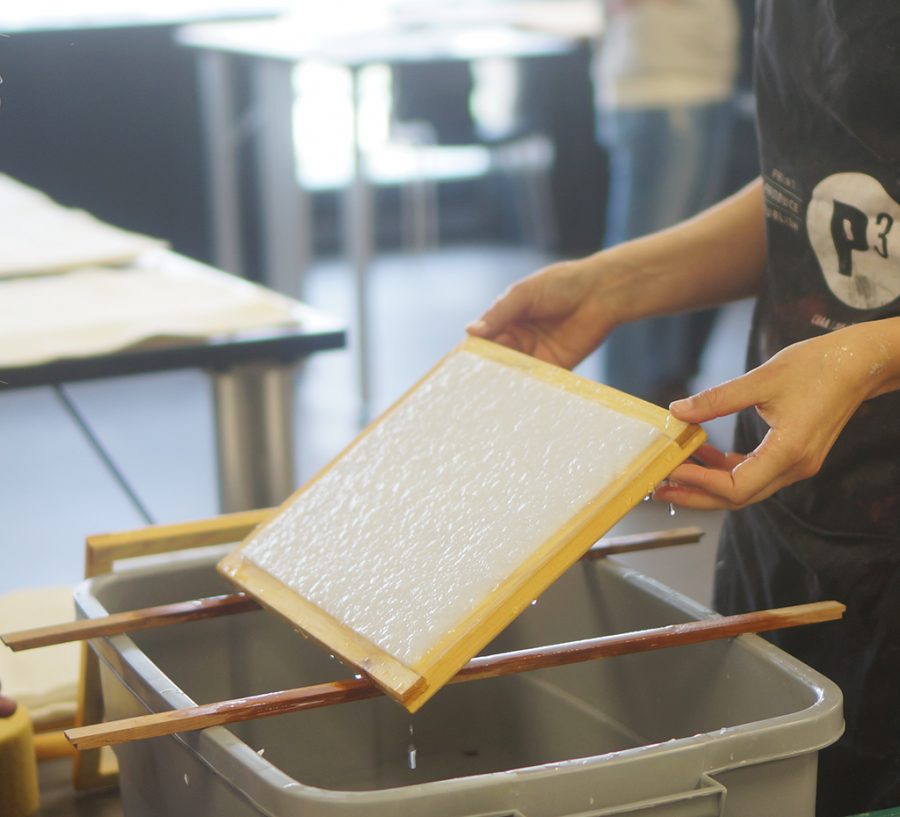Getting Creative With Minors and Certificates
The pulp inside the mold and deckle that is used to create the paper at the U Book Arts Workshop on Friday, April 15, 2016. (Rishi Deka, Daily Utah Chronicle)
July 14, 2022
When we talk about how to pursue the arts on campus, it’s easy to have a specific perspective, one with a fine arts bias that focuses on the five major departments — art and art history, dance, film and media arts, theatre and music. However, getting creative in your degree progression doesn’t necessarily involve these topics.
The University of Utah provides many opportunities for you to get creative even if you aren’t an arts major. If you’re looking to pursue artistic endeavors and earn academic credit for them, adding a minor or certificate might be for you.
Liberal Arts Lens
Even at a tier 1 research university, having a liberal arts approach is valuable across disciplines — general education requirements for every student incorporate a variety of topics and many STEM-adjacent degrees have a humanities core.
If you’re looking to get more hands-on with the arts, the multi-disciplinary design minor, housed in the College of Architecture and Planning, is a rigorous and interdisciplinary program that combines classes that can improve marketable skills. Beyond traditional art forms, students can study graphic design, advertising, visual communication, ecology and even book-binding — one of the more popular non-major courses in the Book Arts Program.
Book Arts started as a part of the J. Willard Marriott Library in 1995 and has evolved into its own unique academic program for majors and non-majors alike to explore book-binding, letterpress printing, papermaking and more. Even if you aren’t enrolled in Book Arts courses, the U holds community programming events and presents exhibitions in the library, even granting studio access to people who’ve completed the foundational courses.
The U is also one of the first schools to have a Dark Sky Studies Program, a component of studying city and metropolitan planning in the College of Architecture and Planning. While this interdisciplinary scientific-based minor might not look artistic, its intention is to “include undergraduate students from across campus.” There are ways to incorporate darkroom photography, creative writing, poetry and design into the program requirements.
Passions Campus is Known For
If you haven’t heard about the Entertainment Arts and Engineering program at the U, its presence provides one of the best examples of getting creative without pursuing traditional performance or visual arts. The EAE Program started over a decade ago with the schools of computing and film coming together and now has become one of the top games programs in the country. Through the EAE Program, you can earn a minor in games, focusing on software development and game-based learning or professional tools. It too is accessible for students in any major who are passionate about games and their development, design and impact.
Hands-On Training for Artists
What if you’re already pursuing an artistic major? There are still opportunities to expand on your degree path, especially at the intersection of art and technology. No matter your medium, tech-related programs exist in every fine arts department.
A minor or certificate in arts technology offers a chance for visual artists to try their hand at digital imaging and web design, whereas a minor or certificate in music technology introduces music students to composition, programming and sound design. There’s even a separate music entrepreneurship certificate that combines school of business coursework with an emphasis on career and start-up development.
Diving into the world of film and technology, the documentary studies minor presents a blend of communication and film courses that culminate in a capstone documentary project. The animation studies minor is similar, blending art and film. Students study animation styles and techniques to better serve film production. Both programs are ways for students with interdisciplinary interests to get hands-on experience in producing work.
For undergraduates in theatre or film and media arts, the screen performance certificate is a way to hone skills in acting, directing, cinematography and screenwriting across departments. For graduate students in modern dance or film & media Arts, the screendance certificate provides both movement and theory classes for those studying this hybrid dance form.
If any of these programs sound like something you’d consider taking on during your time at the U, talking to an academic advisor is key.
Even if you aren’t declared in any of these programs, non-major classes are available in most departments. Student work is also frequently showcased in on-campus events, so you can support the ongoing projects in many of these programs. By adding smaller programs like minors and certificates to your academic career, you can curate your experience on campus to be as creative as you are.








